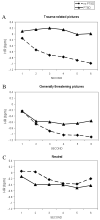Early heart rate responses to standardized trauma-related pictures predict posttraumatic stress disorder: a prospective study
- PMID: 20124426
- PMCID: PMC2865997
- DOI: 10.1097/PSY.0b013e3181d07db8
Early heart rate responses to standardized trauma-related pictures predict posttraumatic stress disorder: a prospective study
Abstract
Objective: To investigate whether chronic posttraumatic stress disorder can be predicted by heart rate responses (HRR) and skin conductance responses (SCR) to standardized trauma-related pictures at 1 month after trauma has ocurred. Trauma survivors with PTSD report heightened physiological responses to a wide range of stimuli. It has been suggested that associative learning and stimulus generalization play a key role in the development of these symptoms. Some studies have found that trauma survivors with PTSD show greater physiological responses to individualized trauma reminders in the initial weeks after trauma than those without PTSD.
Methods: Survivors of motor vehicle accidents or physical assaults (n = 166) watched standardized trauma-related, generally threatening, and neutral pictures at 1 month post trauma, as their HRR and SCR were recorded. PTSD symptoms were assessed with structured clinical interviews at 1 month and 6 months; self-reports of fear responses and dissociation during trauma were obtained soon after the trauma.
Results: At 1 month, trauma survivors with PTSD showed greater HRR to trauma-related pictures than those without PTSD, but not to general threat or neutral pictures. HRR to trauma-related pictures predicted PTSD severity at 1 month and 6 months, and were related to fear and dissociation during trauma. SCR were not related to PTSD.
Conclusion: HRR to standardized trauma reminders at 1 month after the trauma differentiate between trauma survivors with and without PTSD, and predict chronic PTSD. RESULTS are consistent with a role of associative learning in PTSD and suggest that early stimulus generalization may be an indicator of risk for chronic PTSD.
Figures

Similar articles
-
Heart rate responses to standardized trauma-related pictures in acute posttraumatic stress disorder.Int J Psychophysiol. 2010 Oct;78(1):27-34. doi: 10.1016/j.ijpsycho.2010.04.009. Epub 2010 May 5. Int J Psychophysiol. 2010. PMID: 20450940 Free PMC article. Clinical Trial.
-
Auditory startle response in trauma survivors with posttraumatic stress disorder: a prospective study.Am J Psychiatry. 2000 Feb;157(2):255-61. doi: 10.1176/appi.ajp.157.2.255. Am J Psychiatry. 2000. PMID: 10671396
-
Prospective study of posttraumatic stress disorder and depression following trauma.Am J Psychiatry. 1998 May;155(5):630-7. doi: 10.1176/ajp.155.5.630. Am J Psychiatry. 1998. PMID: 9585714
-
Dissociation and memory fragmentation in post-traumatic stress disorder: an evaluation of the dissociative encoding hypothesis.Memory. 2012;20(3):277-99. doi: 10.1080/09658211.2012.655747. Epub 2012 Feb 21. Memory. 2012. PMID: 22348400 Free PMC article. Review.
-
Hippocampal dysfunction effects on context memory: possible etiology for posttraumatic stress disorder.Neuropharmacology. 2012 Feb;62(2):674-85. doi: 10.1016/j.neuropharm.2011.04.029. Epub 2011 May 11. Neuropharmacology. 2012. PMID: 21596050 Free PMC article. Review.
Cited by
-
Neural, psychophysiological, and behavioral markers of fear processing in PTSD: a review of the literature.Curr Psychiatry Rep. 2013 May;15(5):358. doi: 10.1007/s11920-013-0358-3. Curr Psychiatry Rep. 2013. PMID: 23619614 Free PMC article. Review.
-
Fear conditioning, synaptic plasticity and the amygdala: implications for posttraumatic stress disorder.Trends Neurosci. 2012 Jan;35(1):24-35. doi: 10.1016/j.tins.2011.06.007. Epub 2011 Jul 26. Trends Neurosci. 2012. PMID: 21798604 Free PMC article. Review.
-
Negative Emotional Arousal Impairs Associative Memory Performance for Emotionally Neutral Content in Healthy Participants.PLoS One. 2015 Jul 17;10(7):e0132405. doi: 10.1371/journal.pone.0132405. eCollection 2015. PLoS One. 2015. PMID: 26186001 Free PMC article.
-
Emotional State Transitions in Trauma-Exposed Individuals With and Without Posttraumatic Stress Disorder.JAMA Netw Open. 2024 Apr 1;7(4):e246813. doi: 10.1001/jamanetworkopen.2024.6813. JAMA Netw Open. 2024. PMID: 38625701 Free PMC article.
-
How trauma influences cardiovascular responses to stress: contributions of posttraumatic stress and cognitive appraisals.J Behav Med. 2020 Feb;43(1):131-142. doi: 10.1007/s10865-019-00067-8. Epub 2019 Jun 5. J Behav Med. 2020. PMID: 31165948
References
-
- American Psychiatric Association . Diagnostic and statistical manual of mental disorders. 4th edition American Psychiatric Association; Washington, D.C.: 1994.
-
- Ehlers A, Clark DM. A cognitive model of posttraumatic stress disorder. Behav Res Ther. 2000;38:319–45. - PubMed
-
- Litz BT, Keane TM. Information processing in anxiety disorders: application to the understanding of post-traumatic stress disorder. Clin Psych Rev. 1989;9:243–257.
-
- Keane TM, Zimering RT, Caddell JM. A behavioral formulation of posttraumatic stress disorder in Vietnam veterans. Behavior Therapist. 1985;8:9–12.
-
- Foa EB, Steketee G, Rothbaum BO. Behavioral/cognitive conceptualizations of post-traumatic stress disorder. Behavior Therapist. 1989;20:155–76.
Publication types
MeSH terms
Grants and funding
LinkOut - more resources
Full Text Sources
Medical

